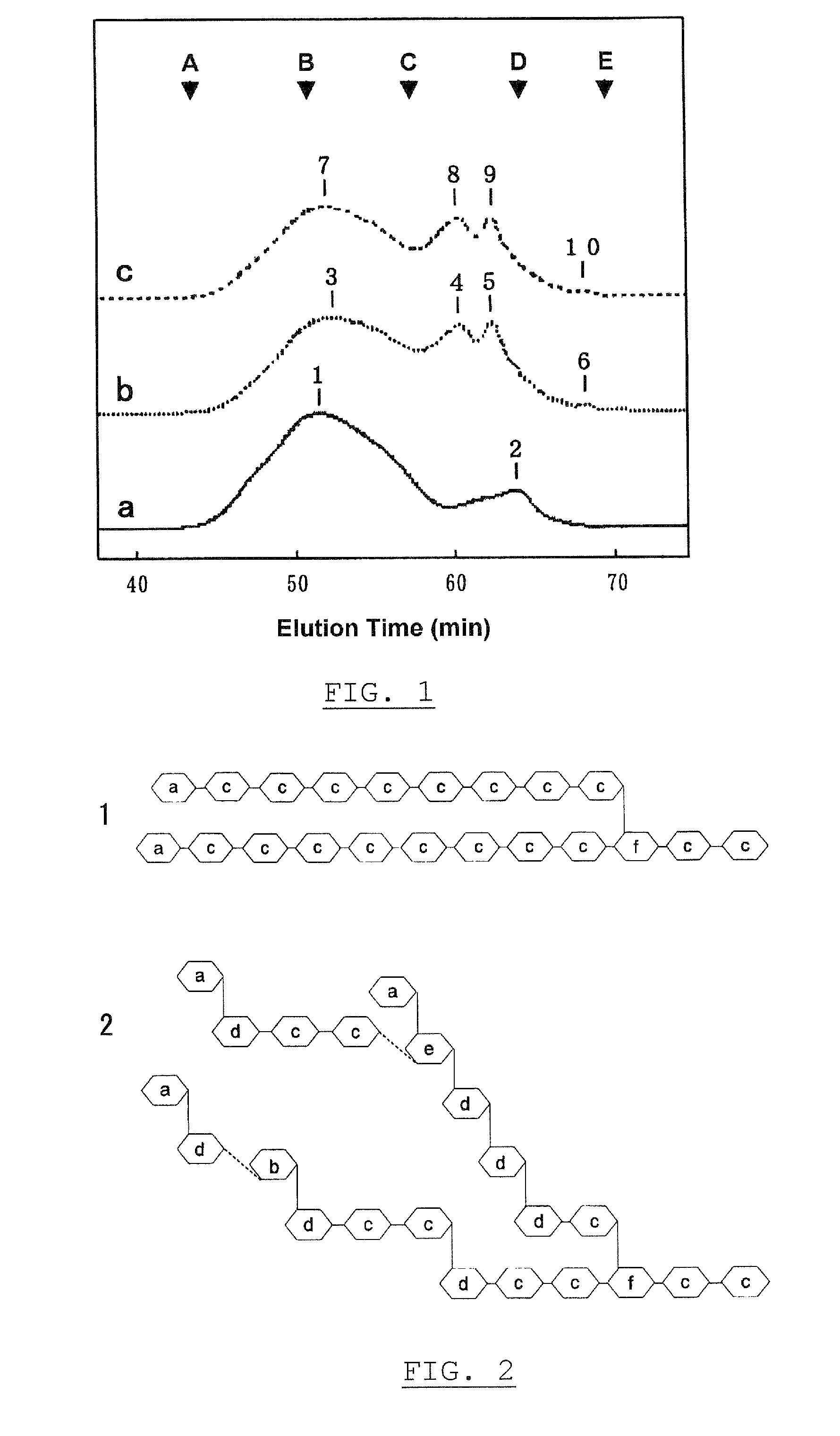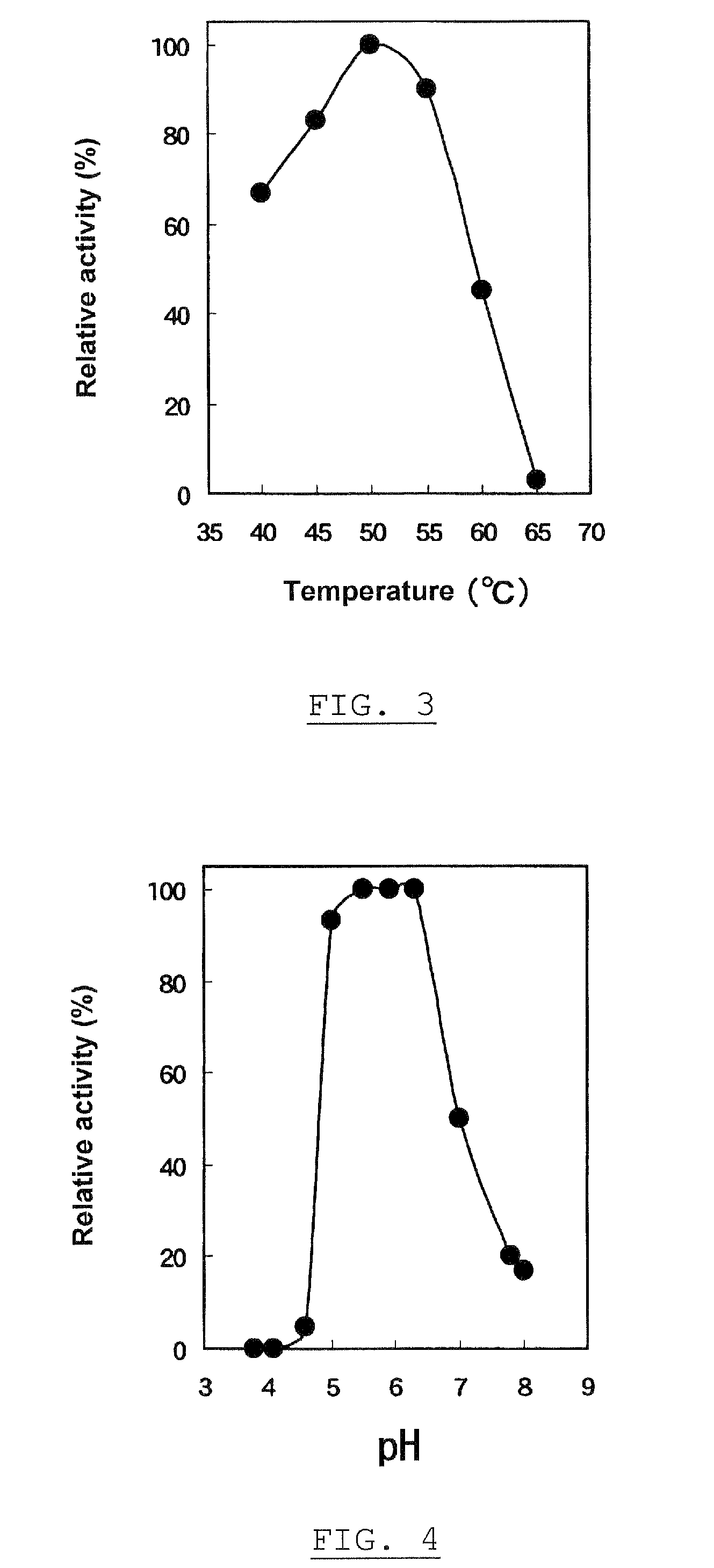Branched α-glucan, α-glucosyltransferase which forms the glucan, their preparation and uses
a technology of branched glucan and -glucosyltransferase, which is applied in the preparation of sugar derivatives, bulk chemical production, bacteria, etc., can solve the problems of easy color-deterioration, narrow use range, and deterioration of relish and texture, and achieves low digestibility, high yield, and white color
- Summary
- Abstract
- Description
- Claims
- Application Information
AI Technical Summary
Benefits of technology
Problems solved by technology
Method used
Image
Examples
experiment 1
Preparation of a Glucan Using α-Glucosyltransferase from Bacillus circulans PP710 (FERN BP-10771)
experiment 1-1
Preparation of α-Glucosyltransferase from Bacillus circulans PP710 (FERN BP-10771)
[0189]A liquid culture medium consisting of 1.5% (w / v) of “PINEDEX® #4”, a partial starch hydrolyzate commercialized by Matsutani Chemical Industries Co., Ltd., Hyogo, Japan, 0.5% (w / v) of “POLYPEPTONE®”, a yeast extract commercialized by Nihon Pharmaceutical Co., Ltd., Tokyo, Japan, 0.1% (w / v) of “YEAST EXTRACT S”, a yeast extract commercialized by Nihon Pharmaceutical Co., Ltd., Tokyo, Japan, 0.1% (w / v) of dipotassium phosphate, 0.06% (w / v) of sodium phosphate dihydrate, 0.05% (w / v) of magnesium sulfate hepta-hydrate, 0.001% (w / v) of manganese sulfate penta-hydrate, 0.001% (w / v) of ferrous sulfate hepta-hydrate, and water was placed in a 500 ml-Erlenmeyer flask in an amount of 100 ml, sterilized by autoclaving at 121° C. for 20 min, and cooled. Successively, the culture medium was inoculated with Bacillus circulans PP710, FERN BP-10771, and followed by cultivation under rotary-shaking conditions at 2...
experiment 1-2
Preparation of a Branched α-Glucan Using α-Glucosyltransferase
[0191]One hundred milliliter of the preparation α-glucosyltransferase, obtained in Experiment 1-1, was used as an enzyme solution. “PINEDEX® #100”, a partial starch hydrolyzate commercialized by Matsutani Chemical Industries Co., Ltd., Hyogo, Japan, was admixed with the enzyme solution to give a final concentration of 30% (w / v), followed by the enzyme reaction at 40° C. for 72 hours, and then heated at about 100° C. for 10 minutes to stop the reaction. After removing the resultant insoluble substances by filtration, the filtrate was decolored and desalted using “DIAION™ SK-1B” and “DIAION™ WA30”, ion exchange resins commercialized by Mitsubishi Chemical Corporation, Tokyo, Japan, and “IRA 411”, an anion exchange resin commercialized by Organ Corporation, Tokyo, Japan. The resulting solution was filtrated and concentrated using an evaporator, and a 30% (w / w) glucan solution was obtained in a yield of 85.8%, on a dry solid ...
PUM
| Property | Measurement | Unit |
|---|---|---|
| pH | aaaaa | aaaaa |
| temperature | aaaaa | aaaaa |
| temperatures | aaaaa | aaaaa |
Abstract
Description
Claims
Application Information
 Login to View More
Login to View More - R&D
- Intellectual Property
- Life Sciences
- Materials
- Tech Scout
- Unparalleled Data Quality
- Higher Quality Content
- 60% Fewer Hallucinations
Browse by: Latest US Patents, China's latest patents, Technical Efficacy Thesaurus, Application Domain, Technology Topic, Popular Technical Reports.
© 2025 PatSnap. All rights reserved.Legal|Privacy policy|Modern Slavery Act Transparency Statement|Sitemap|About US| Contact US: help@patsnap.com



